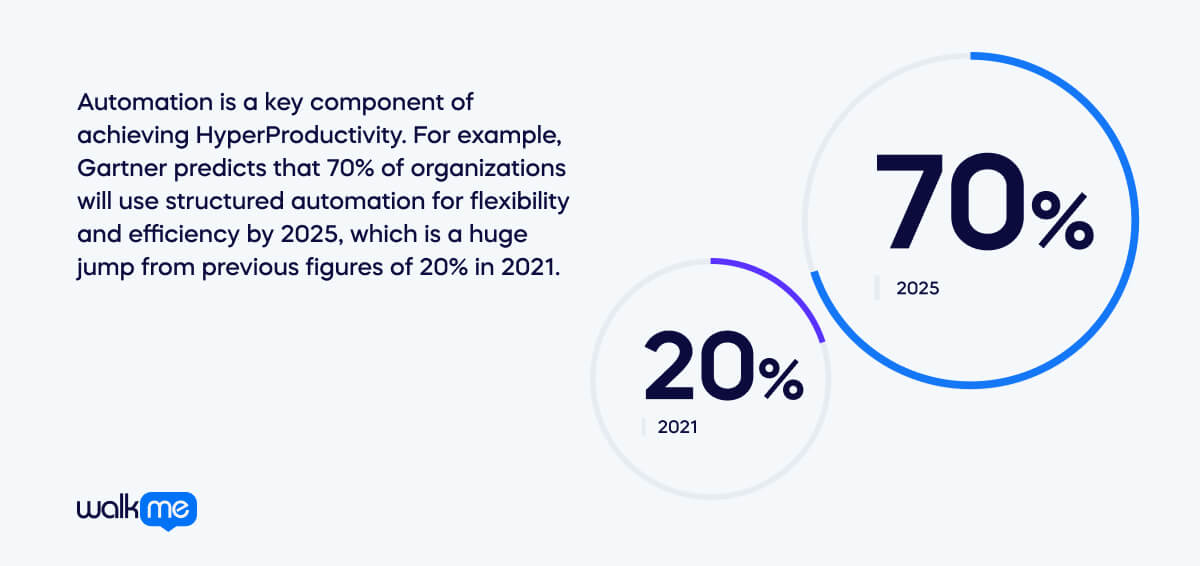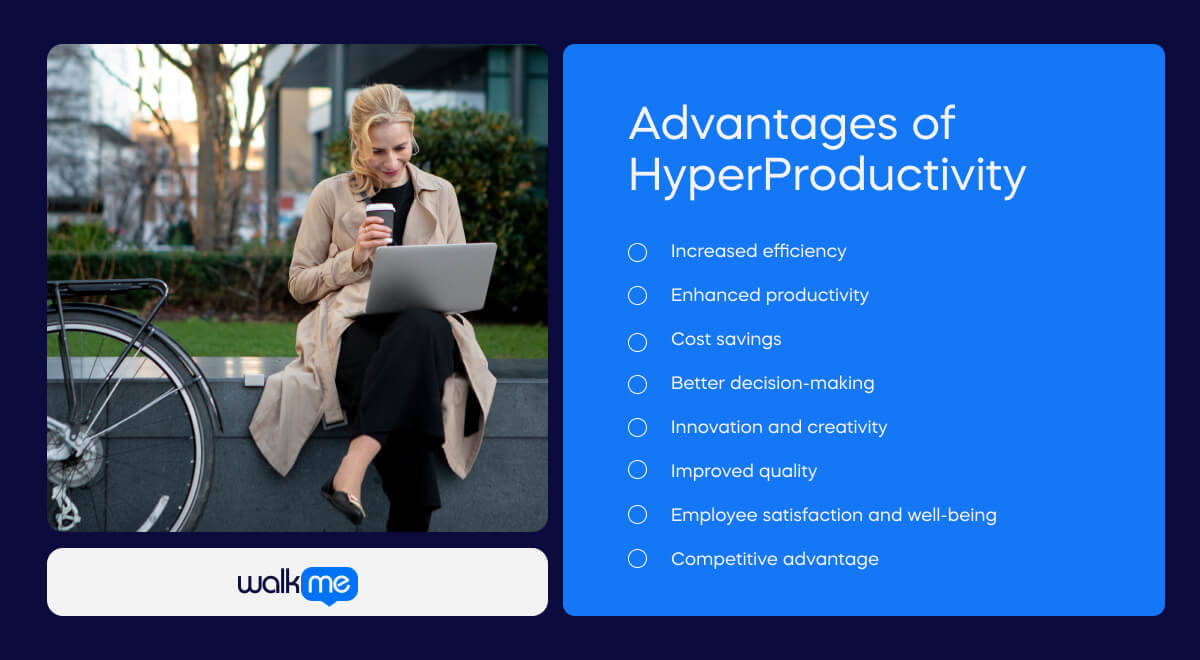What is HyperProductivity?
HyperProductivity refers to an aspirational state in the workplace in which enterprises have automated as many processes as possible and integrated technologies into one cohesive workflow, enabling every employee to use any application with ease.

Table of contents
- What is HyperProductivity?
- Why is HyperProductivity important?
- Use cases for HyperProductivity
- What does a HyperProductive enterprise look like? A conceptual case study.
- HyperProductivity vs Hyper Automation
- Advantages of HyperProductivity
- HyperProductivity: A win for all
- The future of HyperProductivity
A HyperProductive enterprise streamlines non-essential tasks, significantly boosting productivity while allowing employees to focus on impactful work. This requires providing employees with the technology, including artificial intelligence (AI), and support to operate their digital tools faster and more effectively while executing workflows.
And with 80% of executives saying they believe automation can be applied to any business decision, according to a recent Gartner study, many enterprises appear on their way to reaching a state of HyperProductivity.

HyperProductivity extends beyond individual or team success, challenging organizations to replicate and scale these successes organization-wide. It involves expanding digital adoption best practices throughout the entire enterprise, resulting in a more holistic and impactful transformation.
Enterprises that achieve HyperProductivity demonstrate higher application utilization rates and significant time savings for employees across all levels.
Ultimately, HyperProductivity represents a new standard of work that enables companies to maintain a competitive edge and navigate uncertain economic climates while maximizing return on digital investments.
Why is HyperProductivity important?
HyperProductivity is vital for helping enterprises achieve higher levels of efficiency and effectiveness with their digital tools.
WalkMe’s features and solutions help facilitate these processes in many ways.
- WalkMe simplifies and automates complex workflows across multiple applications, reducing errors and increasing efficiency.
WalkMe workflow automation allows users to automate repetitive, tedious, and complex processes, such as clicking buttons, selecting menu items, and moving to the next screen with a single click or a chat command. This saves time, prevents mistakes, and ensures data integrity.
In addition, WalkMe Workstation provides a centralized hub that simplifies information discovery, employee workflows, communication, and application usage by providing access to frequently used apps and files, personalized widgets, desktop and mobile notifications, and resources.
- WalkMe leverages AI to provide personalized and contextual guidance for users, enhancing user experience and satisfaction.
Workstation Enterprise Search lets users securely discover applications and resources with a single unified search, providing personalized, AI-powered results.
WalkMe uses AI to generate and optimize in-app guidance, such as Smart Walk-Thrus, ShoutOuts, Launchers, and Surveys, that help users complete tasks, learn new skills, and get feedback in the flow of work.
Additionally, WalkMe ActionBot enables users to interact with any software through natural language conversations and automated workflows, accelerating productivity and simplifying user experience.
- WalkMe empowers employees to learn and master new technologies, boosting their confidence and performance.
WalkMe’s employee onboarding tools helps employees get up to speed with new software platforms or skill sets by providing a personalized and engaging learning experience that includes checklists, tutorials, videos, and quizzes.
- WalkMe helps enterprises scale and replicate best practices, ensuring consistent and responsible adoption of digital tools.
WalkMe Discovery gives IT executives and enterprise software owners unprecedented visibility into their enterprise software stack by automatically detecting all the web-based apps a company is running, who is using what software, and whether they’re using it as intended.
WalkMe also helps enterprises ensure compliance and security of their digital tools by overlaying guardrails and guidance on top of their AI applications to protect sensitive data and prevent misuse.
- WalkMe measures and analyzes the impact of digital adoption, providing insights and recommendations for improvement and optimization.
WalkMe Insights collects and analyzes user behavior data across applications to help enterprises understand user journeys, identify friction points, measure engagement, and optimize user experience.
WalkMe also provides AI-driven recommendations to improve user workflows, such as where to focus on reducing errors, increasing engagement, and automating tasks.
Use cases for HyperProductivity
HyperProductivity in business
There are a number of advantages that enterprises across all sectors can realize as they strive to reach a state of HyperProductivity. Here are a few examples.
Education
A HyperProductive online learning platform provides the following benefits:
Educators and administrators: Task automation, including grading and student progress tracking, allows educators and administrators to focus on delivering high-quality instruction and personal assistance to students in need.
Students: For students, AI-enhanced adaptive systems personalize the learning experience, analyze performance, and dynamically adjust course content and difficulty levels to optimize progress.
Finance
Automated financial analysis: A HyperProductive financial firm can automate financial analysis processes using AI-powered algorithms to analyze large datasets, detect patterns, and generate insights. This allows financial analysts to quickly assess market trends, evaluate investment opportunities, and make data-driven decisions more accurately and efficiently.
Algorithmic trading: In the finance industry, a HyperProductivity mindset can be applied to algorithmic trading systems that use complex algorithms to execute trades automatically based on predefined criteria. These systems can analyze market conditions in real-time, identify trading opportunities, and execute trades at optimal prices, reducing human error and maximizing returns.
Digital banking services: A HyperProductivity mindset enables the development of digital banking services that streamline financial transactions, automate account management, and provide personalized financial advice to customers. This includes mobile banking apps, digital wallets, and robo-advisors that enhance the customer experience and improve operational efficiency for financial institutions.
Fraud detection and prevention: HyperProductivity can enhance fraud detection and prevention efforts by using AI and machine learning algorithms to analyze transaction data, detect suspicious activities, and flag potential fraudulent behavior in real-time. This helps financial institutions mitigate risks, protect customer assets, and maintain regulatory compliance more effectively.
Customer relationship management (CRM): HyperProductivity can improve customer relationship management in the finance industry by implementing CRM systems that centralize customer data, automate lead generation, and streamline communication channels. This allows financial institutions to better understand customer needs, personalize marketing efforts, and strengthen customer loyalty.
Content creation and marketing
Data-driven content strategy: HyperProductivity enables marketers to develop data-driven content strategies by leveraging AI-enhanced analytics tools to track content performance, measure audience engagement, and identify trends. This allows marketers to optimize content creation efforts, target specific audience segments, and achieve better marketing outcomes.
Marketing automation platforms: HyperProductivity extends to marketing automation platforms that automate repetitive marketing tasks such as email marketing, social media posting, and lead nurturing. By automating routine marketing activities, marketers can focus on strategic initiatives, improve campaign effectiveness, and drive higher ROI.
Content personalization and optimization: HyperProductivity tools enable content personalization and optimization techniques such as A/B testing, dynamic content delivery, and personalized recommendations. This allows marketers to deliver more relevant and engaging content experiences to their target audience, increasing conversion rates and customer satisfaction.
What does a HyperProductive enterprise look like? A conceptual case study.
Background:
Apex Inc. is a leading manufacturer and supplier of industrial equipment with more than 50,000 employees operating in 29 countries.
Challenge:
On January 1, 2023, the German Supply Chain Act (GSCA) came into effect to enhance ESG protections in corporate supply chains. Compliance involves implementing preventive measures within supply chains, submitting annual due diligence reports, and establishing risk mitigation systems. Non-compliance can lead to an €800,000 fine and a three-year exclusion from public contracts.
Solution:
Apex invested in new technology capabilities to ensure employee adherence to restricted party screening, sourcing, and supplier-import-export management procedures. Apex realized they would not achieve compliance in time or scope using traditional methods; to expedite the process and ensure governance at scale, they implemented an AI-enabled DAP to:
- Provide a unified conversational interface to act and automate workflows.
- Identify and mitigate digital friction across workflows without increasing support tickets.
- Utilize real-time guidance and support to accelerate process completion in the flow of work.
Outcomes:
- 1.5m productivity hours saved through low-code process implementation, task automation and improved data validation.
- 600% increase in EU-customer retention rates achieved through enhanced competitive advantage.
- €1.1 billion in net-new EU public sector contracts.
*This is a composite hypothetical case study.
HyperProductivity vs Hyper Automation
HyperProductivity and hyper-automation are both concepts aimed at enhancing efficiency and effectiveness within organizations. While there are distinctions between the two concepts, they are ultimately complementary and are both critical for meeting enterprise goals.
Automation is a key component of achieving HyperProductivity. For example, Gartner predicts that 70% of organizations will use structured automation for flexibility and efficiency by 2025, which is a huge jump from previous figures of 20% in 2021.
However, the two concepts aren’t quite the same. Let’s compare the two:
| HyperProductivity | Hyper Automation | |
| Definition | Achieving increased output by automating business processes into one cohesive workflow. | Automating tasks and workflows using advanced technologies |
| Key components | Process optimization, cultural shifts, technology adoption, AI fueled task automation. | Robotic process automation, AI, machine learning, integration |
| Objectives | Maximize output, accelerate time-to-market, drive growth | Increase operational efficiency, reduce manual effort |
| Example activities | Implementing agile methodologies, investing in employee training | Deploying RPA bots, using AI-powered chatbots, integrating systems |
| Focus | Efficiency, resource utilization | Automation, scalability, error reduction |
While HyperProductivity focuses on maximizing output and efficiency through process optimization, cultural shifts, and resource utilization, hyper-automation centers on leveraging advanced technologies to automate tasks, processes, and workflows to achieve operational excellence and scalability.
Both concepts are essential for organizations looking to stay competitive and adapt to the demands of the digital age.

Advantages of HyperProductivity
HyperProductivity offers several advantages to individuals, teams, and organizations:
Increased efficiency
HyperProductivity enables individuals and teams to accomplish exponentially more in less time by optimizing workflows, streamlining processes, and eliminating inefficiencies. This leads to higher output and faster task completion.
Enhanced productivity
By focusing on high-priority tasks, leveraging advanced tools and technologies, and adopting effective time management strategies, HyperProductivity results in dramatically improved productivity levels, allowing individuals and teams to achieve their goals more effectively.
Cost savings
By reducing waste, minimizing downtime, and maximizing resource utilization, HyperProductivity can lead to significant cost savings for organizations. This includes savings on labor costs, operational expenses, and overheads.
Better decision-making
HyperProductivity encourages data-driven decision-making and iterative problem-solving, enabling individuals and teams to make informed decisions quickly and adapt to changing circumstances more effectively.
Innovation and creativity
By fostering a culture of continuous improvement, experimentation, and collaboration, HyperProductivity encourages organizational innovation and creativity. This can lead to developing new ideas, products, and services that drive growth and competitive advantage.
Improved quality
HyperProductivity emphasizes quality over quantity, encouraging individuals and teams to deliver work of the highest standards. This leads to better outcomes, increased customer satisfaction, and enhanced reputation for the organization.
Employee satisfaction and well-being
By providing individuals with the tools, resources, and support they need to succeed, HyperProductivity contributes to higher levels of employee satisfaction, engagement, and well-being. This reduces turnover, increases morale, and a more positive work environment.
Competitive advantage
Organizations that embrace HyperProductivity gain a competitive edge in their industries by delivering superior products and services, responding quickly to market changes, and outperforming competitors in terms of efficiency, innovation, and customer satisfaction.

HyperProductivity: A win for all
HyperProductivity reshapes operational dynamics by transforming how individuals, teams, and organizations approach work, productivity, and efficiency.
It reshapes operational dynamics by:
- Automating business processes into a single cross-application workflow.
- Enables employees to fully utilize their digital tools.
- Emphasizing efficiency and effectiveness in achieving organizational goals.
- Encouraging a culture of continuous improvement, innovation, and adaptability.
- Leveraging technology and data-driven insights to optimize processes and decision-making.
- Fostering collaboration, communication, and teamwork to enhance productivity and creativity.
- Driving organizational agility and responsiveness to changing market conditions and customer needs.
- Establishing a competitive advantage through superior performance, customer satisfaction, and market leadership.
Connected concepts such as agile methodologies, lean principles, digital transformation, and organizational culture contribute to the wider narrative by providing frameworks, strategies, and practices to support HyperProductivity.
- Agile methodologies enable iterative and adaptive project management, allowing teams to respond quickly to changes and deliver value incrementally.
- Lean principles focus on eliminating waste and optimizing processes to enhance efficiency and productivity.
- Digital transformation involves leveraging technology to digitize operations, automate tasks, and innovate business models, enabling organizations to achieve HyperProductivity in the digital age.
- Organizational culture is critical in fostering an environment that values productivity, collaboration, learning, and well-being, driving sustained success and growth.
This holistic approach enables organizations to thrive in today’s fast-paced and competitive business environment.
The future of HyperProductivity
Business leaders recognize the importance of digital acceleration, or the process of adopting and integrating digital technologies and capabilities into an organization’s strategy, operations, and culture.
It enables HyperProductivity by providing the necessary tools, platforms, and data to support agile development, innovation and decision-making.
A survey from Gartner reveals that digital acceleration was the top spending priority for CFOs over the following 12 months, indicating that these leaders recognize the value and potential of digital acceleration as assisting initiatives such as HyperProductivity for their organizations.
Moreover, they are willing to allocate resources and capital to achieve them. The shift towards digital acceleration is not just a trend, but a strategic imperative for businesses aiming to thrive in the modern marketplace.
With CFOs leading the charge in prioritizing digital initiatives like HyperProductivity, organizations are poised to harness the full potential of digital technologies to drive innovation, agility, and decision-making.
This proactive approach signals a clear commitment to embracing digital transformation as a catalyst for sustained growth and competitiveness.